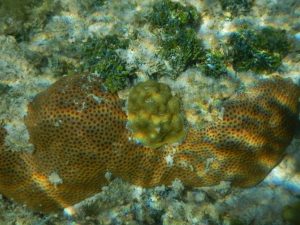Day 13: May 27th 2018, Glover’s Atoll
Today we woke up to pouring rain and grey skies. After running to escape the rain, we ate breakfast at 7 and then decide to push up lectures while we waited out the rain. Today was our final day of lectures to our delight and Professor Solomon’s disappointment. The lectures were on Crustaceans, Sponges, and Mangroves and Seagrass.
Once there rain slowed to a drizzle, we were off to our morning activity. We designed a project to ask and answer a question about marine debris on the island. We decided to ask about the amount and composition of trash on the windward side of the island vs the leeward side of the island. Essentially, the breeze tends to blow towards the windward side of the island and not the leeward (opposite side); hence, we hypothesized that we would find a greater amount and different types of trash materials on the leeward side. We essentially wen collected trash fro 15 minutes on each side recording the types and number of materials as we went. After we had collected our data, it was time for lunch and we were all hungry.
After lunch, we had our last official snorkel trip. I saw sooooo many types of hard coral. I can only hope that I correctly identified them and will not bring shame upon Adrienne haha. I saw Mustard Hill Corals, Lesser Starlet Corals, Symmetrical Brain corals, Grooved Brain Corals, Smooth Star Corals, Elliptical Star Corals (mostly in the sea grass), Club Tip Finger Corals, Lettuce Corals (surprisingly hard to spot on the lower sodden of rocks),… (heavy breathing…) Great Star Corals, Knobby Brain Corals, a large Acropora palmata (Elkhorn Coral), and a tiny Acropora cervicornis (Staghorn Coral).
I also saw several types of parrot fish, a Queen Triggerfish, an Eagle Ray, and a Nurse Shark that was about 6 ft long (very large for a nurse shark). The sad part was that the shark had a plastic bottle attached to it. Why do humans litter? We don’t even see how much we hurt out environment.
Speaking of debris, after dinner, we analyzed the data from the marine debris project. What we found was actually the opposite of our hypothesis. While we found more trash in weight on the windward side, we found a greater number of smaller trash pieces on the leeward side as well as a greater variety of materials. This is because lighter, transportable trash can be pushed away from the windward side towards the leeward side while larger, heaver materials like hard plastics remain on the windward side. Its was an interesting conclusion, but I think we all could agree that it was sad to see so much trash in such a beautiful place.
Big take away: we need to be more conscious our our human impact, especially in first world countries.

